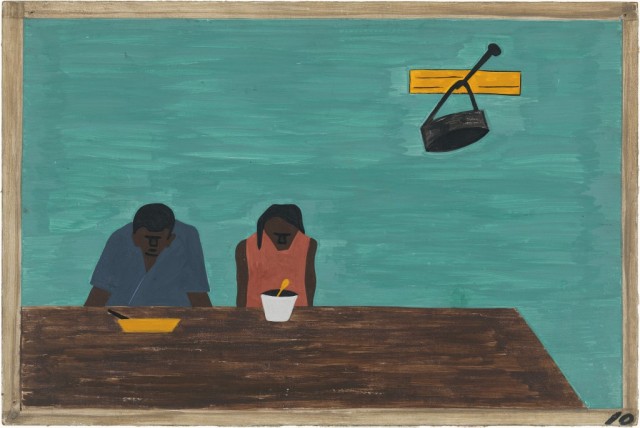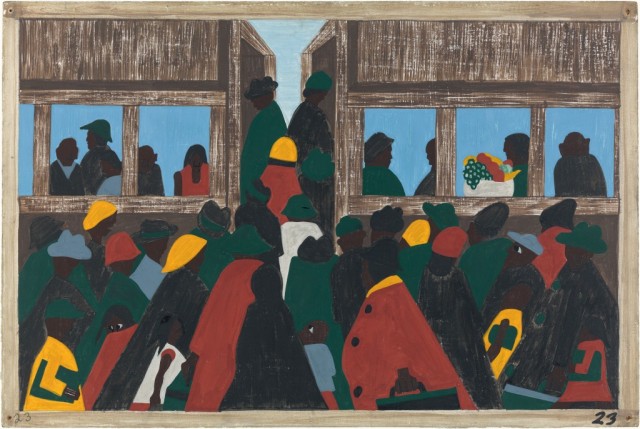
Jacob Lawrence, the Migration Series, 1940-41, Panel 10: “They were very poor,” casein tempera on hardboard (© 2015 the Jacob and Gwendolyn Knight Lawrence Foundation, Seattle / Artists Rights Society, New York)
Museum of Modern Art
Special Exhibitions Gallery, third floor
11 West 53rd St. between Fifth & Sixth Aves.
Through September 7, $25 (including audio program and film screenings)
212-708-9400
www.moma.org
Jacob Lawrence, who was born in 1917 in Atlantic City and moved with his family to Harlem when he was thirteen, depicted the twentieth-century African American experience in stunning, colorful panels painted in a style he called dynamic cubism. Half of his seminal 1941 series about the Great Migration is regularly on view at MoMA, but for this special exhibit, the midtown institution has teamed with the Phillips Collection, which owns the other half, to present the complete sixty-piece work for the first time in New York in twenty years. Lawrence was twenty-three when he created the Migration Series, tracing the movement of African Americans from the south to the north in search of a better life, beginning during the WWI era and continuing into the 1960s. Each panel is a work of art that stands on its own, but together they paint a fascinating portrait that unfolds like a documentary film. The works are arranged chronologically at eye level around the large gallery, with the caption for each right underneath the panel. Taken as a whole, it’s a dizzying array of dazzling color, but individually they tell quite a story as well.

Jacob Lawrence, the Migration Series, 1940-41, Panel 23: “In a few sections of the South the leaders of both groups met and attempted to make conditions better for the Negro so that he would remain in the South,” casein tempera on hardboard (© 2015 the Jacob and Gwendolyn Knight Lawrence Foundation, Seattle / Artists Rights Society, New York)
In panel 1, men, women, and children line up at the train station to leave for Chicago, New York, or St. Louis, yellows and blues peeking out among muted browns and greens. In panel 5, a train is barreling past, black smoke floating back, a bright light beaming ahead. In panel 10, a man and a woman are sitting at a table, staring down at their meager food; the caption succinctly states: “They were very poor.” In panel 10, a white judge looks down from on high at two black men huddled below; the caption explains: “Among the social conditions that existed which was partly the cause of the migration was the injustice done to the Negroes in the courts.” In panel 18 (“The migration gained in momentum”), the departure of the men, women, and children is almost biblical in nature, evoking the exodus. Throughout the sixty panels, Lawrence plays with perspective and geometric as well as abstract shapes and patterns, creating scenes that often swirl with movement and life. The Migration Series is a towering achievement, an emotionally powerful work that feels as relevant today as it did when it was first presented more than sixty years ago. The exhibit is supplemented with paintings and drawings by Charles Alston, Romare Bearden, and Charles White, archival footage of Marian Anderson, Duke Ellington, and Billie Holiday, photographs by Dorothea Lange, Ben Shahn, and Gordon Parks, writings by Langston Hughes, Claude McKay, and Richard Wright, and other ephemera related to black life in America in the early to mid-twentieth century. And be sure to visit the excellent MoMA website that examines each panel of the Migration Series in detail.